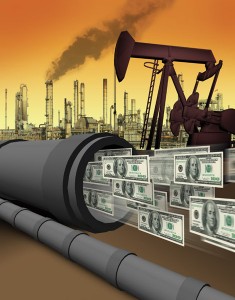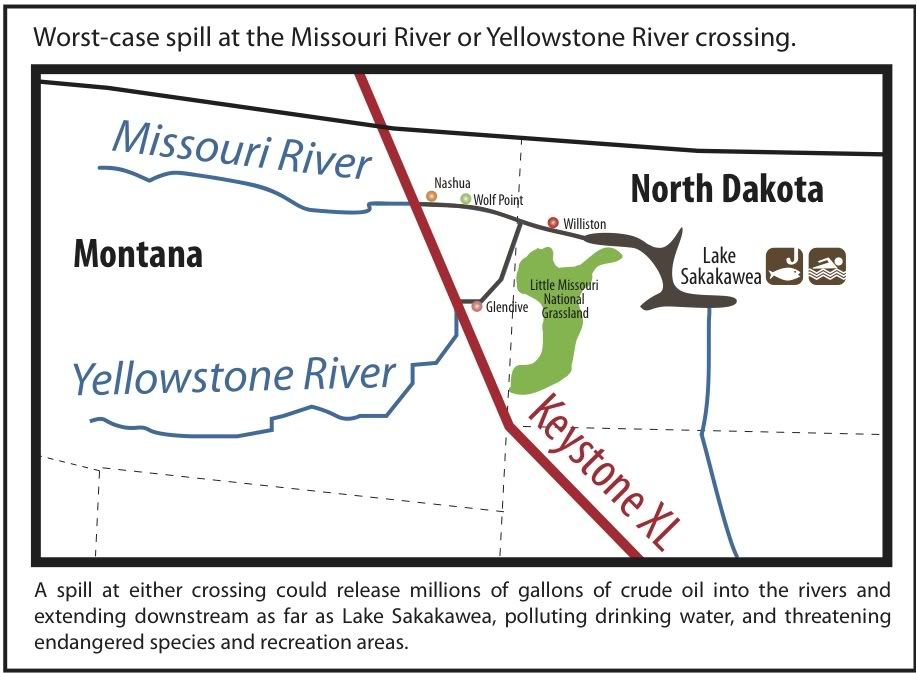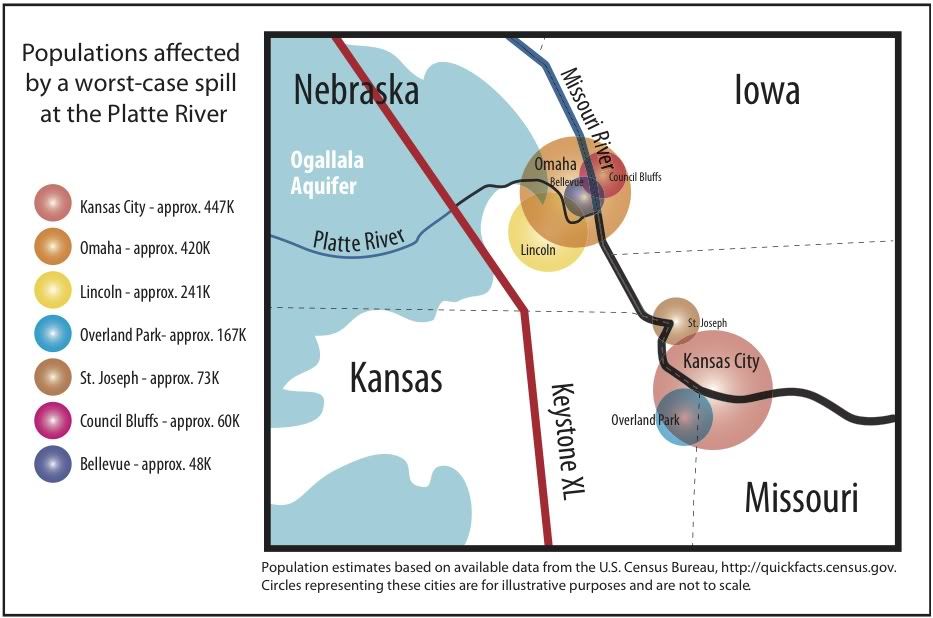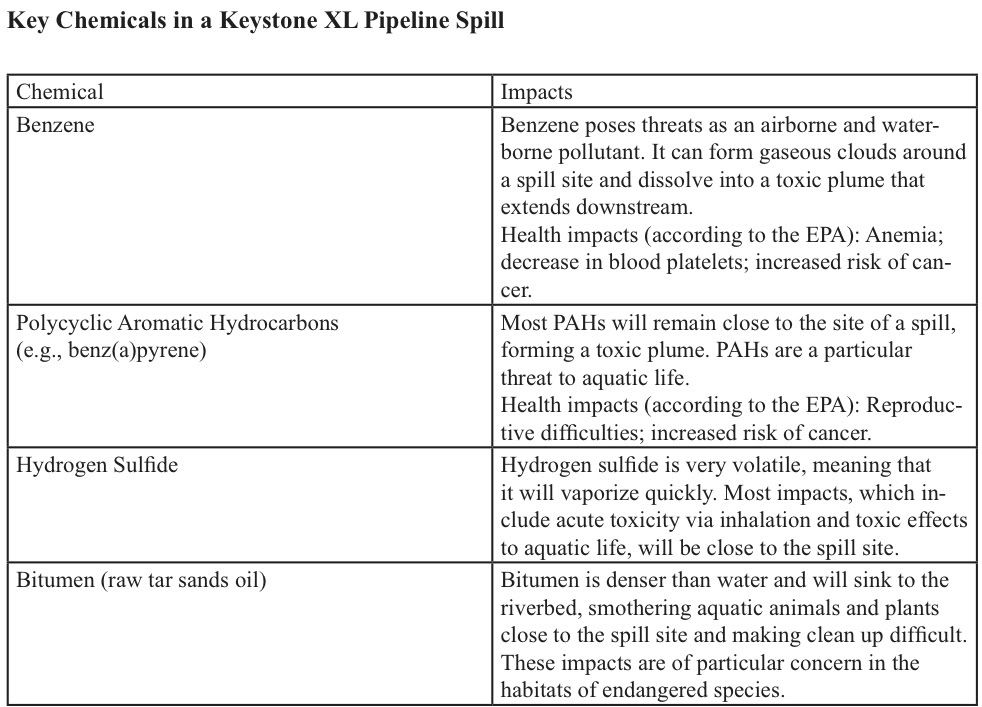An independent analysis performed by University of Nebraska professor Dr. John Stansbury, an environmental engineer, claims that TransCanada’s safety assessments for their proposed Keystone XL pipeline are misleading and based on faulty information. The Keystone XL pipeline would carry crude oil from Alberta, Canada to Texas, crossing numerous states in the U.S.
TransCanada, the company hoping to build the pipeline, was required under the Clean Water Act to conduct a complete review and present their data on worst-case-scenario oil spills from their proposed pipeline. According to his new report titled “Keystone XL Worst-Case Spills Study,” Dr. Stansbury’s analysis of TransCanada’s government reports found that their methodology for determining the safety of their pipeline was inherently flawed because the company deliberately relied on information that was known to be false.
Among the major findings from Dr. Stanbury’s report:
While TransCanada estimates that the Keystone XL will have 11 significant spills (more than 50 barrels of crude oil) over 50 years, a more realistic assessment is 91 significant spills over the pipeline’s operational lifetime.
TransCanada arbitrarily and improperly adjusted spill factors to produce an estimate of one major spill on the 1,673 miles of pipeline about every five years, but federal data on the actual incidence of spills on comparable pipelines indicate a more likely average of almost two major spills per year. (The existing Keystone I pipeline has had one major spill and 11 smaller spills in its first year of operation.)
Analysis of the time needed to shut down the pipeline shows that response to a leak at a river crossing could conservatively take more than ten times longer than the 11 minutes and 30 seconds that TransCanada assumes. (After the June 2010 spill of more than 800,000 gallons of crude oil into a tributary of the Kalamazoo River, an Enbridge tar sands pipeline – a 30 inch pipe compared to the 36-inch Keystone XL – was not completely shut down for 12 hours.)
Realistic calculations yield worst-case spill estimates of more than 180,000 barrels (about 7.9 million gallons) in the Nebraska Sandhills above the Ogallala Aquifer, more than 160,000 barrels (about 6.9 million gallons) of crude oil at the Yellowstone River crossings, more than 140,000 barrels (about 5.9 million gallons) at the Platte River crossing and more than 120,000 barrels (about 5.2 million gallons) at the Missouri River crossing.
One of the main categories that Stansbury says TransCanada left out of their computations was the “other causes” category for oil spills. “Other causes” are identified as spills with no apparent cause – pipeline erosion, busted pipes, explosions – and account for as much as 23% of all pipeline spills. By not factoring these potential causes into their analyses, TransCanada was able to downplay the likelihood of a major spill.
During a media briefing on Monday morning, Dr. Stansbury said that when these factors are calculated, we can expect no fewer than 2 major spills per state during the 50-year projected lifetime of the pipeline. These spills could release as much as 5 – 7 million barrels of oil each.
Another factor that led to TransCanada’s low spill estimate is that they relied on technological improvements to help protect the Keystone XL pipeline. However, as Stansbury tells us, they are only calculating enhanced computer monitoring technology, not enhanced pipeline construction, which will only alert the company to a leak, not help to prevent one. This is a very significant point, because as we reported in June, TransCanada has freely admitted that their oversight of the pipeline is going to be scarce. By their own admission, TransCanada will have very few foot patrols along the pipeline, and most of the monitoring will be done by bi-weekly flyovers which will not be able to identify an underground leak.
Additionally, their proposed computer systems will not be able to identify pinhole leaks, which could potentially lead to thousands of gallons of oil escaping the pipeline for months before the company notices. TransCanada’s own documents, as detailed by Stansbury, show that the company acknowledges that pinhole leaks could take as long as 90 days to detect.
One of the main concerns for the pipeline itself, and one that makes the possibility of spills even more likely, is that the pipeline will be delivering what is known as diluted bitumen (DilBit.) This form of crude oil is much more corrosive than traditional crude oils, meaning that the pipeline will suffer wear and tear at a significantly increased rate.
Stansbury’s report also outlines the dangers of a potential oil spill. Because the pipeline will travel through numerous states, each with their own unique environment and wildlife, it is nearly impossible to fully predict what sort of impact a spill would have. The report says the following about the impacts of a spill near an aquifer:
The primary constituents of concern in surface water are: benzene, PAHs, hydrogen sul- fide, and bulk crude oil. The amounts of these constituents in the surface water are affected by several factors including: the concentration of the constituent in the crude oil, the solubility of the constituent, and the turbulence and velocity of the water. Constituents of special concern are benzene and certain PAHs because they are carcinogenic.
Contaminants from a release at the Missouri or Yellowstone River crossing would enter Lake Sakakawea in North Dakota where they would adversely affect drinking water intakes, aquatic wildlife, and recreation. Contaminants from a spill at the Platte River crossing would travel downstream un- abated into the Missouri River for several hundred miles affecting drinking water intakes for hundreds of thousands of people (e.g., Lincoln, NENENEMOMO) as well as aquatic habitats and recreational activities. In addition, other constituents from the spill would pose serious risks to humans and to aquatic species in the river.
The worst-case site for such a spill is in the Sandhills region of Nebraska. The Sandhills are an- cient sand dunes that have been stabilized by grasses. Because of their very permeable geology, nearly 100 percent of the annual rainfall infiltrates to a very shallow aquifer, often less than 20 feet below the surface. This aquifer is the well-known Ogallala Aquifer that is one of the most productive and impor- tant aquifers in the world.
Stansbury provided the following maps to illustrate the most vulnerable areas, as well as the main chemicals that would be released into the air, water, and terrestrial environment from a spill:
In the wake of ExxonMobil’s recent Yellowstone River oil spill, the severity and inevitability of oil spills are fresh on the minds of the American public. But as time ticks on, TransCanada continues to inch closer and closer to getting their Keystone XL pipeline approved by the Obama administration. The political odds are in their favor, as the Checks and Balances Project blog points out the political ties that TransCanada has to the current administration:
TransCanada’s main Washington, DC lobbyist is Paul Elliot, who served as the Secretary of State’s national deputy director for her failed presidential run in 2008. This cozy relationship has resulted in several organization filing requests to see the discussions between Clinton and Elliot throughout this process. Currently, the Secretary of State’s office is in the review stages of the approval process for the pipeline, which if given the go-ahead would allow for 900,000 barrels of crude to be pumped into the United States every day.
If the EPA allows TransCanada’s flawed spill report to pass the test, Americans and Canadians alike could see construction of the Keystone XL pipeline in the near future. Dr. Stansbury’s report raises serious questions about the consequences of approving this unsafe pipeline, which is essentially guaranteed to leak oil into the waterways and properties of nearby communities. Why would the Obama administration approve such a disaster in the making?
Subscribe to our newsletter
Stay up to date with DeSmog news and alerts










